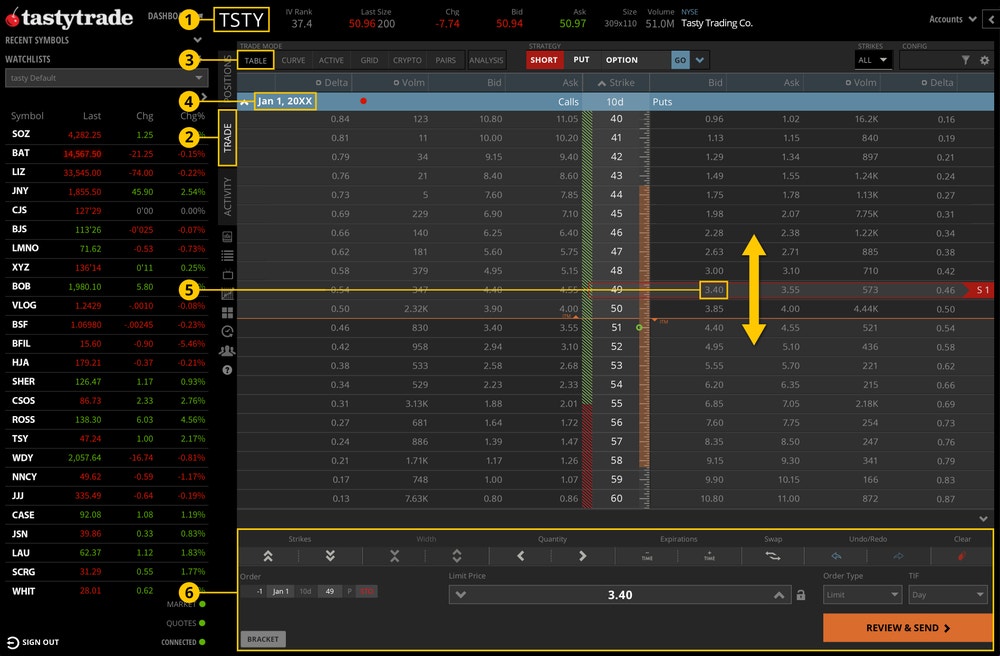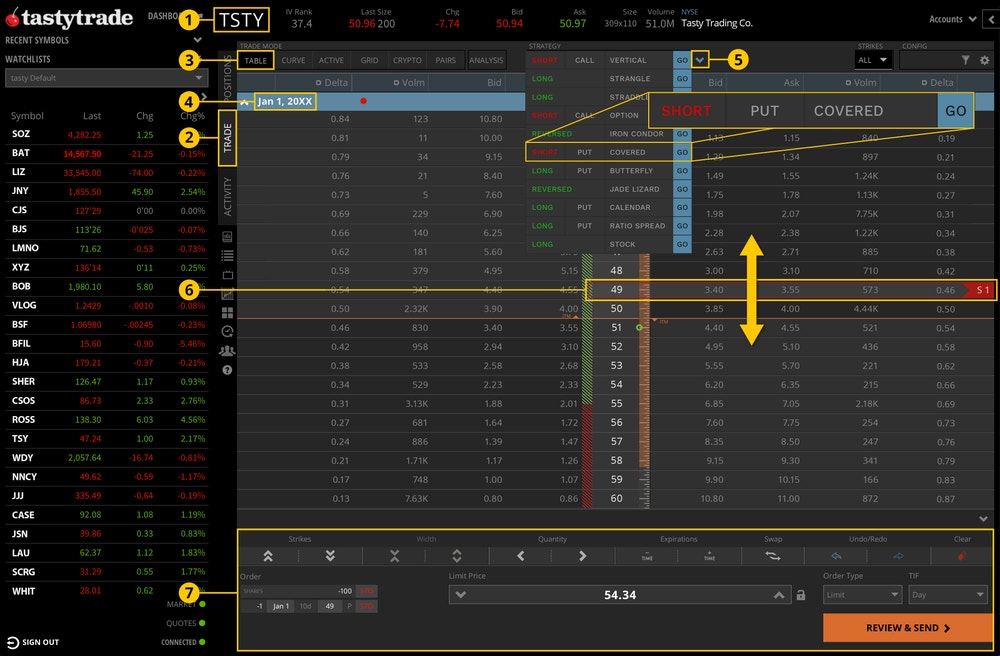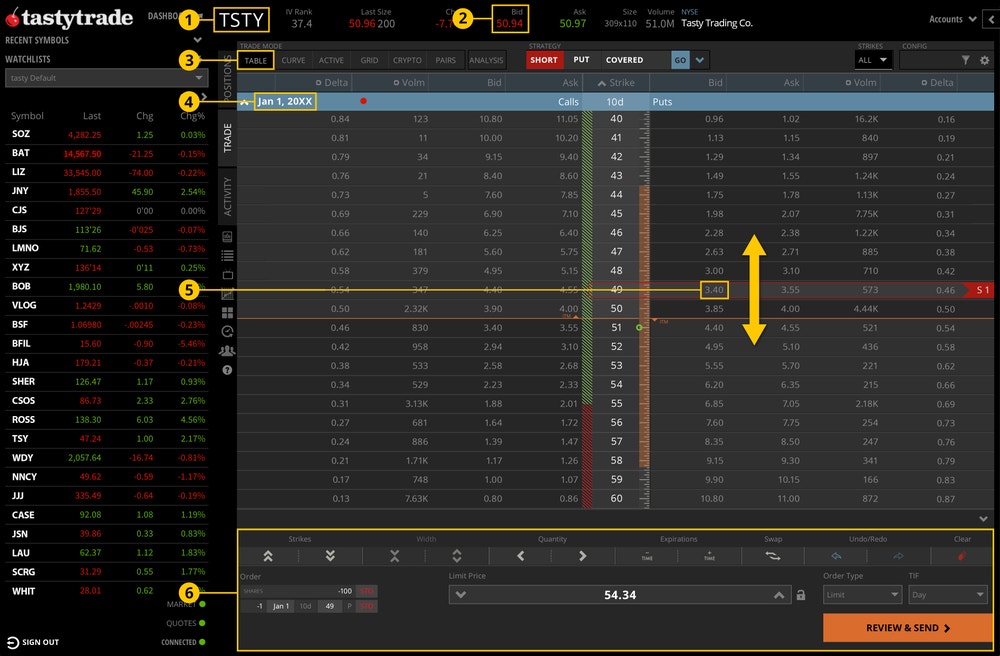Covered Put Options Strategy
Covered Put Summary
- Selling a put against every 100 short shares enables investors to generate potential income on their short stock holdings.
- A put option seller must buy the stock at the option's strike price, which will cover the short shares if the long holder exercises early or if it expires in-the-money (ITM) by $0.01 or more at expiration.
- A put sold at a strike above the short stock trade price could result in locked-in losses if the investor is put long shares by assignment.
- Although an investor can generate potential interim income by selling a short put against a short stock position, an investor still faces unlimited risk on the short shares.
Covered Put
The covered put strategy consists of selling an out-of-the-money (OTM) put against every 100 short shares or ETF shares an investor has in their portfolio, as illustrated below. While this strategy allows investors to generate potential interim income on short shares and caps profits, investors are still subject to unlimited risk due to the short shares.

Unlike long stock, investors with a short stock position benefit when the share price falls. As a result, selling an out-of-the-money (OTM) put against any round lot of short shares will cap profits since it limits downside exposure. For example, an investor holding 200 short shares of XYZ @ $50 can sell 2 $45-strike puts against it. It's worth noting that establishing or maintaining a short stock position is only allowed in a margin account, so establishing a covered put in any other kind of account is not permitted.
Since each long put gives the buyer a right to sell 100 shares of stock at the option's strike price, a put option seller must buy the stock at the option's strike price if the long holder exercises early or if it expires in-the-money (ITM) by $0.01 or more at expiration. In short, options buyers buy a right to sell shares at the option’s strike price, and sellers are obligated to buy 100 shares per contract at the option's strike when the long holder exercises or if it expires ITM.
Assuming the put option sold against the short stock position remains OTM during the life of the trade, the value of the put option sold may erode each day due to time decay. As a result of remaining OTM and time decay, it potentially can be covered (purchased back) below the selling price to yield a profit. A put option that expires OTM at expiration will be worthless and yield a max profit. The profit from the covered put positions may help generate income for investors with short stock positions. Additionally, investors short any dividend-paying stocks may offset any dividends owed or carrying costs with any profits made by selling covered puts too. Carrying costs refer to hard-to-borrow fees charged to investors that establish short stock positions in a heavily shorted stock.
A covered put gets its name since each short put covers 100 short shares if assigned early or expiring ITM. Assuming an account with only a covered put position in their portfolio, the account would be flat (no shares) and prevent it from being long 100 shares if the option faces early assignment or if it expires ITM.
Although selling a put against 100 short shares to form a covered put position can potentially generate interim income or potentially offset any dividends or carrying costs owed from a short stock position, this strategy has unlimited risk as you are holding a short stock position. If the stock price rises, it could yield a profit on the short put position, but the gain may not cover the losses sustained from the stock price rise since it can, in theory, rise infinitely. Additionally, puts sold above the short stock’s sale basis could result in locked-in losses if the account experiences an early assignment or by expiring ITM, which would cover or close the short shares.
For example, if you originally opened 100 short shares of XYZ @ $50, but it is currently trading at $70, then selling a $60-strike put for a $1 credit against the short shares could lock in a $1,000 loss on the short shares, or a $900 total loss when considering the credit received on the 60-strike short put, if the short share were covered early by assignment of or if XYZ closed ITM below $60 at expiration. Learn more about options.
Profit & Loss Diagram of a Covered Put
The profit and loss diagram below assumes the covered put sold below the short stock's basis. Since investors selling covered puts are selling their downside, an investor's max profit will cap when the underlying drops below the covered put's strike price, as illustrated where the green profit zone flattens. Theoretically, a short stock position has unlimited losses since it can continually rise in perpetuity. The potential profit on the short put may not cover the losses on the appreciated shares.

Covered Puts vs. Sell-Writes
A sell-write is like the covered put strategy. The main difference between the two strategies is how each order is placed. A sell-write is established by shorting 100 shares (a round lot) and selling an out-of-the-money put against the shares simultaneously in a single order.
For example, if the shares were trading at $450, setting up a sell-write would involve selling to open 100 shares at the current market price and selling to open a 420 strike put for $20 against it in one order ticket. The opening sell-write order would result in $47,000 ($45,000 proceeds from short stock sale + $2,000 credit received) in short proceeds, as illustrated below.

A covered put implies selling a put against an existing round lot of short stock previously established in your portfolio. When an investor sells a put against an existing short stock position, the order ticket only comprises a short put in the order ticket instead. The risk profile of a covered put will resemble a sell-write, assuming the put sold is below the short stock sale price.
In short, covered puts and sell-writes are the same position. The difference lies in the timing of selling the put, whether when establishing the short stock position or against an existing short stock position in your portfolio.
What's Required for a Covered Put?
A covered put position requires a round lot of 100 shares of short stock for every short put
- 100 short shares also known as a round-lot (per hundred shares)
- One short put per round-lot of short stock
Example of a Covered Put
Portfolio already holds 100 short shares of XYZ @ $55, which is the basis for the short sale. The current price of XYZ is $50.
- Sell to Open 1 XYZ $45-strike put for $2 credit ($200 total credit received)
Covered Put | Sell-Write | |
|---|---|---|
Time Decay Effect | Works for the seller as time can decay the value of the put sold | Works for the seller as time can decay the value of the put sold |
Max Profit | Short Stock + Short Put ((Short sale basis – short put strike) x 100) + total credit received ((55-45) x 100) + $200 = $1,200 Only the Short Put Total credit received $200 | Short Stock + Short Put ((Short sale basis + short put strike) x 100) + total credit received ((50-45) x 100) + $200 = $700 Only the Short Put Total credit received $200 |
Max Loss | Infinite due to short shares | Infinite due to short shares |
Breakeven Price | Short stock sale basis + credit received $55 + $2 = $57 | Short stock sale basis + credit received $50 + $2 = $52 |
Buying Power Requirement | No additional buying power required when selling a short put against an existing short share position | 100 short shares, less premium received from selling the put |
Account Type Required | Margin* | Margin* |
Covered Put | |
|---|---|
Time Decay Effect | Works for the seller as time can decay the value of the put sold |
Max Profit | Short Stock + Short Put ((Short sale basis – short put strike) x 100) + total credit received ((55-45) x 100) + $200 = $1,200 Only the Short Put Total credit received $200 |
Max Loss | Infinite due to short shares |
Breakeven Price | Short stock sale basis + credit received $55 + $2 = $57 |
Buying Power Requirement | No additional buying power required when selling a short put against an existing short share position |
Account Type Required | Margin* |
Sell-Write | |
|---|---|
Time Decay Effect | Works for the seller as time can decay the value of the put sold |
Max Profit | Short Stock + Short Put ((Short sale basis + short put strike) x 100) + total credit received ((50-45) x 100) + $200 = $700 Only the Short Put Total credit received $200 |
Max Loss | Infinite due to short shares |
Breakeven Price | Short stock sale basis + credit received $50 + $2 = $52 |
Buying Power Requirement | 100 short shares, less premium received from selling the put |
Account Type Required | Margin* |
*Holding or establishing a short stock position requires a margin account with the highest trading level: The Works.
How to Sell a Covered Put
Using the Strategy Menu
Since a Covered Put implies that the investor already has at least a round-lot of short shares established, all an investor needs to do to establish the position is to sell a put to open. That said, you can still use the menu by selecting Short and Put, as illustrated below.
- Enter a symbol.
- Navigate to the Trade tab.
- Go to Table mode.
- Click on an expiration date to expand.
- Click the Strategy Menu, and locate the option strategy, and (from left to right) click each column to display Short, Put, and Go.
- The short put will populate in the expanded expiration. Click and drag the put to the desired strike price.
- Go to the order ticket to determine the quantity, price, time-in-force (TIF), etc., before clicking "Review & Send" to send the order.

Building it Manually
- Enter a symbol
- Navigate to the Trade tab
- Go to Table Mode
- Click on an expiration date to expand (on the Table mode)
- Click on the bid price of the put strike
- Go to the order ticket to determine the quantity, price, time-in-force (TIF), etc., before clicking "Review & Send" to send the order

How to Set up a Sell-Write
Using the Strategy Menu
- Enter a symbol.
- Navigate to the Trade tab.
- Go to Table mode.
- Click on an expiration date to expand.
- Click the Strategy Menu and locate the Covered strategy, and (from left to right) click each column to display Short, Put, and Go.
- The short put will populate in the expanded expiration. Click and drag the put to the desired strike price.
- The order ticket will list the shares and corresponding short put in it to determine the quantity, price, time-in-force (TIF), etc., before clicking "Review & Send" to send the order.

Building it Manually
- Enter a symbol.
- Click the Bid price of the stock quote to prepare a short stock order.
- You will reach the Trade tab and an order ticket will appear below. Go to Table mode.
- Click on an expiration date to expand (on the Table mode).
- Click on the Bid price of the put you want to sell, and the short put will also appear on the order ticket.
- Go to the order ticket to determine the quantity, price, time-in-force (TIF), etc., before clicking "Review & Send" to send the order.

Options involve risk and are not suitable for all investors as the special risks inherent to options trading may expose investors to potentially significant losses. Please read Characteristics and Risks of Standardized Options before deciding to invest in options.
Trading in a margin account is not suitable for all investors as trading on increased leverage can result in significant losses in the event of adverse market movements. It is important that investors understand the risks involved in trading securities on margin prior to investing in a margin account. Please read the Margin Disclosure Statement.
All investments involve risk of loss. Please carefully consider the risks associated with your investments and if such trading is suitable for you before deciding to trade certain products or strategies. You are solely responsible for making your investment and trading decisions and for evaluating the risks associated with your investments.